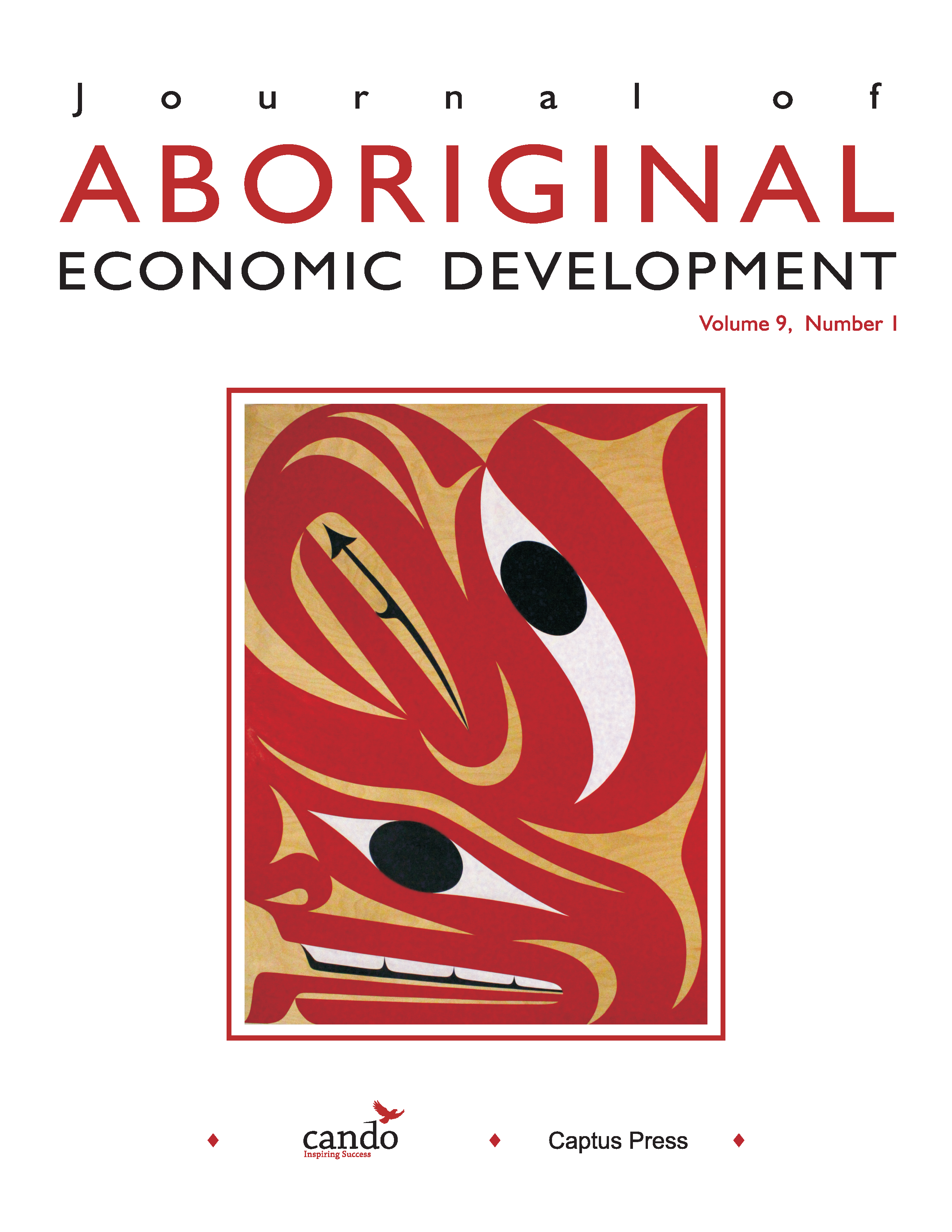Balancing Politics and the Dispersal of Business Revenues among First Nations in Saskatchewan, Canada
DOI:
https://doi.org/10.29173/jaed343Keywords:
Business, Business And Economics, Citizens, Decision making, Economic development, Ethnic Interests, Family allowances, Federal government, Funding, Native North Americans, Older people, Political leadership, Politics, Revenue, Social development, Social programs, Social welfare, Welfare services, First Nation businesses in Canada, First Nation-owned Businesses, First Nation Institutions, Saskatchewan First Nations, Indigenous community development, Indigenous community economic development, Indigenous economic leadership, Indigenous economic developmentAbstract
In this paper we present the results of interviews conducted with 14 First Nations in Saskatchewan on the ways in which they balance the need for economic development while meeting the social welfare needs of community members. Specific themes include (i) the separation between business and politics; (ii) the existence and role of boards of directors; (iii) strategic versus reactive decision-making; and (iv) the tension between revenue reinvestment and disbursement. Among the First Nations interviewed, three have put into place formal structures to separate business from politics, and have prioritized strategic and long-term investment over revenue dispersal. The remaining 11 First Nations use economic development as a vehicle to meet the social welfare needs of community members, including the funding of social program, Elders care, family allowances, and host of other social welfare services. This paper offers insight into the challenges First Nation governments encounter as they struggle to meet the diverse needs of their citizenry.
Downloads
References
Anderson, R.B., and R.M. Bone. (1995). First Nations Economic Development: A Contingency Perspective. The Canadian Geographer, 39(2): 120–130.
Assembly of First Nation, (n.d.). Policy Areas. Online: <http://www.afn.ca/index.php/en/policy-areas> (accessed December 17, 2013).
Brody, Hugh. (2000). The Other Side of Eden: Hunters, Farmers and the Shaping of the World. Vancouver: Douglas and McIntyre.
Cornell, Stephen. (2006). What Makes First Nations Enterprises Successful: Lessons from the Harvard Project. Joint Occasional Papers on Native Affairs No. 2006-01. Native Nations Institute for Leadership, Management and Policy and The Harvard Project on American Indian Economic Development. University of Arizona, Tucson.
Dowling, Christina. (2005). The Applied Theory of First Nations Economic Development. Journal of Aboriginal Economic Development, 2(4): 120–128.
Gibson, Kathy. (2000). Accounting as a Tool for Aboriginal Dispossession: Then and Now. Accounting, Auditing and Accountability Journal, 13(3): 289–306.
Grant, Kenneth, and Jonathan Taylor. (2006). Managing the Boundary between Business and Politics: Strategies for Improving the Chances for Success in Tribally Owned Enterprises. In Miriam Jorgenson (ed.), Rebuilding Nation Nations: Strategies for Governance and Development. 175–196. Tucson: University of Arizona Press.
Helin, Calvin. (2006). Dances with Dependency: Out of Poverty Through Self-Reliance. California: Ravencrest Publishing.
Jorgenson, Miriam. (Ed.). (2007). Rebuilding Native Nations: Strategies for Governance and Development. Tucson: University of Arizona Press.
Kalt, Joseph. (2008). The State of the Native Nations: Conditions under U.S. Policies of Self-Determination. London: Oxford University Press.
MacDonald, David, and Daniel Wilson. (2013). Poverty or Prosperity: Indigenous Children in Canada. Ottawa: Canadian Centre for Policy Alternatives.
Mowbray, Martin. (2006). Localising Responsibility: The Application of the Harvard Project on American Indian Development in Australia. Australian Journal of Social Issues, 41(1): 92– 104.
Natcher, David C., Rose Olfert, Albert Boiaty, and Tom Allen. (2013). Political Stability and the Well-Being of First Nations in Saskatchewan: Implications for the Proposed First Nations Elections Act. Journal of Aboriginal Economic Development, 8(2): 97–111.
Newhouse, David. (2001). Resistance in Futile: Aboriginal People Meet the Borg of Capitalism. Journal of Aboriginal Economic Development, 2(1): 75–82.
Neu, Dean, and Richard Therrien. (2003). Accounting for Genocide: Canada’s Bureaucratic Assault on Aboriginal Peoples. London: Zed Books.
Quesnel, Joseph. (2012). The Fifth Aboriginal Governance Index: Expecting Good Governance on Prairie First Nations. Policy Series No. 134. Winnipeg: Frontier Centre for Public Policy.
Royal Commission on Aboriginal Peoples. (1996). Report. 5 vols. Ottawa: Minister of Supply and Services Canada.
Schwartz, Daniel. (2013). How Does Native Funding Work? CBCNews, February 6 (accessed November 13, 2013).
Weir, Warren I. (2007). First Nation Small Business and Entrepreneurship in Canada. Research Paper for the National Centre for First Nation Governance. Ottawa.
Witkin, Belle Ruth, and James W. Altschuld. (1995). Planning and Conducting Needs Assessments: A Practical Guide. California: Sage Publications.
Wuttunee, W. (2010). Aboriginal Perspectives on the Social Economy. In J.J. McMurtry (ed.), Living Economics: Canadian Perspectives on the Social Economy, Co-operatives, and Community Economic Development. 179–216. Toronto, ON: Emond Montgomery Publisher.
Wuttunee, W., M. Chicilo, R. Rothney, and L. Grey. (2008). Financing Social Enterprise: An Enterprise Perspective. Working Paper, Institute for the Study of Co-operatives. Saskatoon: University of Saskatchewan.
Downloads
Published
Issue
Section
License
Copyright (c) 2014 Cando

This work is licensed under a Creative Commons Attribution-NonCommercial-NoDerivatives 4.0 International License.




